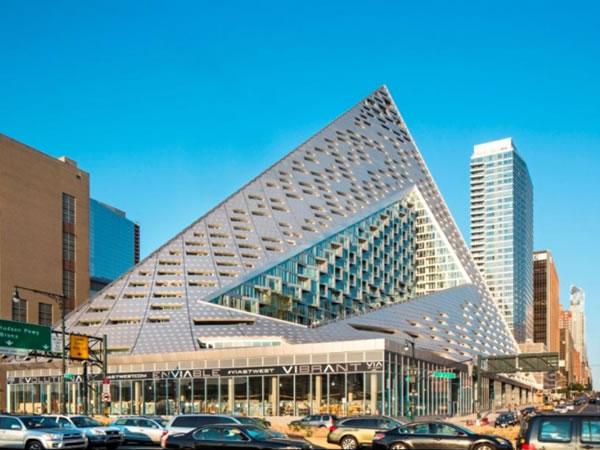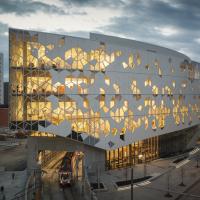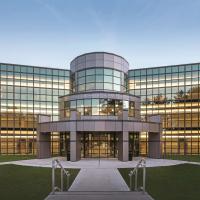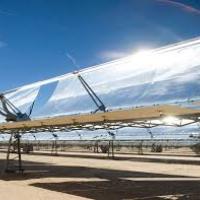
Date: 13 August 2019
Vitro Architectural Glass (formerly PPG Glass) announced that it has changed the name of Solarban® 70XL solar control low-emissivity (low-e) glass to Solarban 70 glass, formally dropping the “XL”.
Robert J. Struble, manager, brand and communications, Vitro Architectural Glass, emphasized that, despite the name change, there have been no changes to the glass formulation itself. “Since Solarban 70XL glass was introduced, the distribution channel, and even our own employees commonly truncated the name to ‘Solarban 70,’ so to alleviate confusion throughout the supply chain, we decided to adopt the product name everyone most commonly uses,” he explained. “The product remains available in annealed, heat-strengthened, tempered and laminated version through the Vitro Certified™ Network of glass fabricators.”
Introduced at the GreenBuild International Conference and Expo in 2006, Solarban 70 glass was the first architectural glass to successfully integrate a third layer of reflective silver into a low-e coating. That not only enabled the glass to outperform the best double-silver-coated low-e glasses of the time, it also greatly expanded the opportunity for architects to incorporate large spans of transparent glass into their building designs.
Today, Solarban 70 glass remains the industry’s best-performing, most trusted triple-silver-coated, solar control low-e glass. “We know, based on architectural specifications, that Solarban 70 is the most preferred triple-silver low-e glass on the market,” Struble noted. “Specifiers have told us that this is due to Solarban 70 glass’s consistent levels of quality and color uniformity, as well as performance.”
Solarban 70 glass has been specified for thousands of buildings, including recent high-profile projects such as Bjarke Ingels’ VIA 57 West in New York and 181 Fremont by Heller Manus Architects, the new 55-story LEED Platinum-certified tower in San Francisco. In addition, many residential and commercial window manufacturers are expanding their use of Solarban 70 glass to meet increasingly stringent energy performance codes.
Due to its proprietary, triple-silver coating, Solarban 70 glass transmits 64 percent of the sun’s light in a standard one-inch insulating glass unit, while blocking 73 percent of its heat energy. Solarban 70 glass also is Cradle to Cradle Certified™ at the Bronze level by the Cradle to Cradle Products Innovation Institute.
For more information about Solarban 70 glass, or to request a glass sample, visit www.vitroglazings.com or call 1-855-VTRO-GLS (887-6457).
About Vitro Architectural Glass
Vitro Architectural Glass, part of Vitro, S.A.B. de C.V. (BMV:VITROA), the largest company of its kind in the Americas, manufactures a range of industry-leading, energy-efficient products such as Solarban®, Sungate® and Starphire Ultra-Clear®glasses at U.S. plants in Carlisle, Pennsylvania; Fresno, California; Salem, Oregon; and Wichita Falls, Texas. Committed to sustainable manufacturing processes and products, the company also operates one of the world’s largest glass research and development facilities in Pittsburgh and four residential glass fabrication plants in Canada. Upholding the values of “Together, We See Further” across the architectural, automotive and containers markets, Vitro strives to realize the power of partnership to ensure that projects meet or exceed ever-evolving sustainability expectations as well as glass requirements. For more information, please visit www.VitroGlassHub.com.
Vitro Certified is a trademark and Solarban, Sungate and Starphire Ultra-Clear are registered trademarks owned by Vitro.
LEED—an acronym for Leadership in Energy and Environmental Design—is a registered trademark of the U.S. Green Building Council.
Cradle to Cradle Certified is a trademark licensed by the Cradle to Cradle Products Innovation Institute.

Photography by Tom Kessler
Vitro Architectural Glass (formerly PPG Glass) has changed the name of Solarban® 70XL solar control low-emissivity (low-e) glass to Solarban 70 glass, formally dropping the “XL”. Introduced in 2006, it was the first architectural glass to successfully integrate a third layer of reflective silver into a low-e coating. Solarban 70 glass has been specified for thousands of buildings, including recent high-profile projects such as 181 Fremont (pictured, left) by Heller Manus Architects, a new 55-story LEED Platinum-certified tower in San Francisco, and Bjarke Ingels’ VIA 57 West in New York (pictured, right). Many residential and commercial window manufacturers also are expanding their use of Solarban 70 glass to meet increasingly stringent energy performance codes.
 600450
600450




















Add new comment